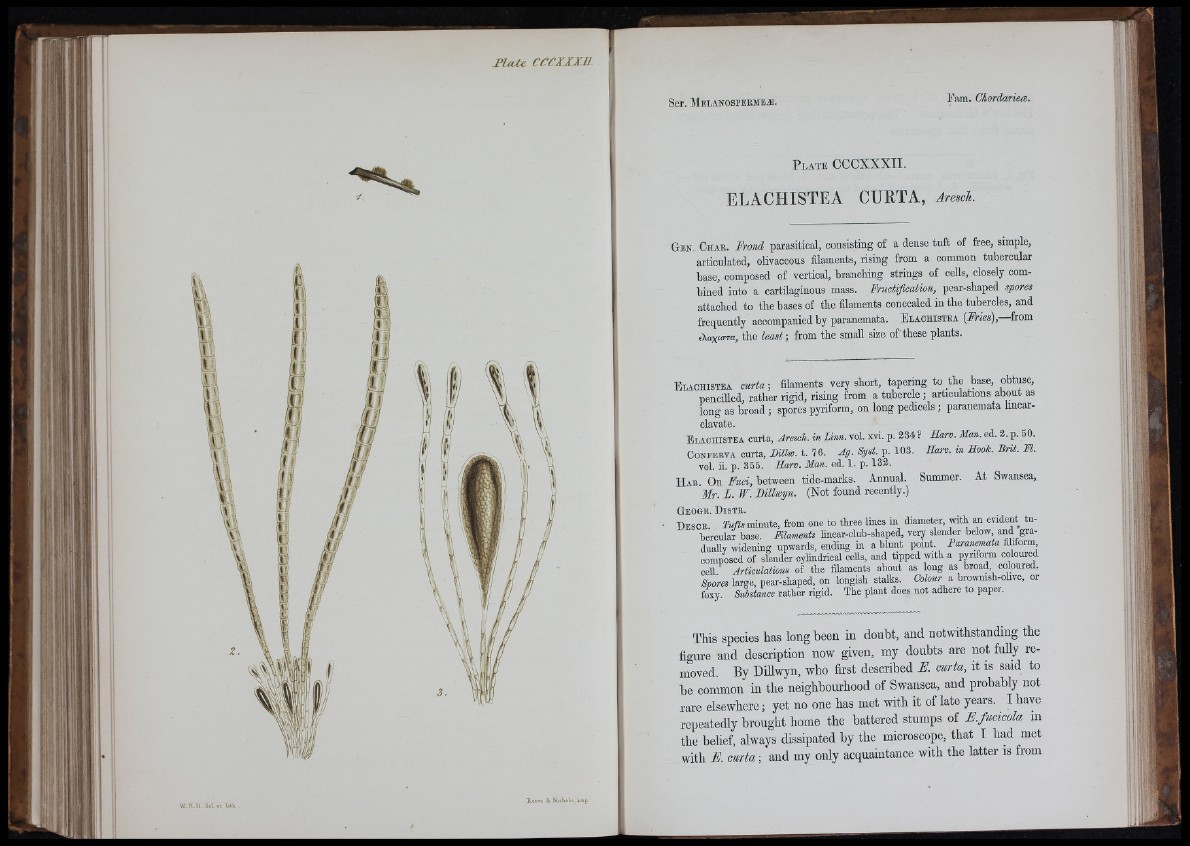
P l a t e CCCXXXII.
ELACHISTEA CURTA, Aresch.
Gen. C h a e . Frond parasitical, consisting of a dense tuft of free, simple,
articulated, olivaceous filaments, rising from a common tubercular
base, composed of vertical, branching strings of cehs, closely combined
into a cartilaginous mass. Frnetifieation, pear-shaped spores
attached to the bases of the filaments concealed in the tubercles, and
frequently accompanied by paranemata. E lachistea {Fries),— b om
eXaxta-ra, the leo s t; from the small size of'these plants.
E lachistea curta; filaments very short, tapering to the base, obtuse,
pencilled, rather rigid, rising from a tubercle; articulations about as
ong as broad; spores pyriform, on long pedicels; paranemata linear-
clavate.
B laohistea c u r t a , Aresch. in Linn. v o l . x v i . p . 2 3 4 ? H a n . Man. e d . 2 . p . 5 0 .
C o n f e r v a c u r t a , Dillw. t . 7 6 . Ag. Syst. p . 1 0 3 . H a n . in Hook. Brit. M.
v o l . i i . p . 3 5 5 . H a n . Man. e d . 1 . p . 1 3 2 .
H a b . On Fuci, between tide-marks. Annual. Summer. At Swansea,
Mr. L . W. Dillwyn. (Hot found recently.)
G e o g r . D is t r .
D e s c r Tuflsxmmxie, f r o m o n e t o t h r e e l i n e s i n d i a m e t e r , w i t h a n e v i d e n t t u b
e r c u l a r b a s e . Filaments l i n e a r - c l u b - s h a p e d , v e r y s l e n d e r b e l o w a n f f i g r a d
u a l l y w i d e n i n g u p w a r d s , e n d i n g i n a b l u n t p o i n t Baranenmta m o rm
c o m p o s e d o f s l e n d e r c y l i n d r i c a l c e l ls , a n d t i p p e d w i t h a p y r i f o rm c o lo u i - e d
c e l l Articulations o f t h e f i l a m e n t s a b o u t a s l o n g a s b r o a d , c o l o u r e d .
Spmes l a r g e , p e a i '- s h a p e d , o n l o n g i s h s t a l k s . Colour a b r o w m s h - o h v e , o r
f o x y . /S i iS s t e c c r a t h e r r i g i d . T h e p l a n t d o e s n o t a d h e r e t o p a p e i .
This species has long been in doubt, and notwithstanding the
figure and description now given, my doubts are not fully removed.
By Dillwyn, who first described E. curta, it is said to
be common in the neighbourhood of Swansea, and probably not
rare elsewhere; yet no one has met with it of late years. I have
repeatedly brought home the battered stumps of E.fueicola in
the belief, always dissipated by the microscope, that I had met
with E. curta; and my only acquaintance with the latter is from
■1